Dynamic Expansion and Merging of the Equatorial Ionization Anomaly During the 10–11 May 2024 Super Geomagnetic Storm
Abstract
1. Introduction
2. Instruments and Data Sets
3. Results
4. Discussion
4.1. EIA Crests Expansion During the Main Phase
4.2. EIA Crests Merging During the Recovery Phase
5. Conclusions
- During the main phase of the superstorm, the low- and mid-latitude ionosphere experienced a strong positive storm, with GNSS TEC showing drastic enhancements of 50–100% in a few hours. In the meantime, the EIA crests exhibited a remarkable poleward expansion, reaching latitudes as high as ±35° MLAT. This phenomenon can be predominantly attributed to the super-fountain effect driven by strong PPEF associated with the strongly southward excursion of IMF Bz. Additionally, transient poleward wind surges likely enhanced ambipolar diffusion, further contributing to the poleward shift of the EIA crests.
- During the recovery phase of the superstorm, the global ionosphere was characterized by a substantial negative storm, marked by a 50–80% depletion in GNSS TEC. Simultaneously, the EIA crests in the American–Atlantic sector were severely suppressed and collapsed toward the equator, merging into a single equatorial band. This phenomenon is likely related to the composition change effect, with O/N2 being significantly enhanced in the equatorial region while being depleted at higher latitudes. In addition, westward DDEF likely played a role in contributing to the merging of the EIA crests.
Author Contributions
Funding
Data Availability Statement
Conflicts of Interest
Correction Statement
References
- Appleton, E.V. Two Anomalies in the Ionosphere. Nature 1946, 157, 691. [Google Scholar] [CrossRef]
- Balan, N.; Liu, L.; Le, H. A brief review of equatorial ionization anomaly and ionospheric irregularities. Earth Planet. Phys. 2018, 2, 257–275. [Google Scholar] [CrossRef]
- Duncan, R.A. The equatorial F-region of the ionosphere. J. Atmos. Terr. Phys. 1960, 18, 89–100. [Google Scholar] [CrossRef]
- Fejer, B.G. Low latitude storm time ionospheric electrodynamics. J. Atmos. Sol.-Terr. Phys. 2002, 64, 1401–1408. [Google Scholar] [CrossRef]
- Huang, C.S.; Sazykin, S.; Chau, J.L.; Maruyama, N.; Kelley, M.C. Penetration electric fields: Efficiency and characteristic time scale. J. Atmos. Sol.-Terr. Phys. 2007, 69, 1135–1146. [Google Scholar] [CrossRef]
- Abdu, M.A.; de Paula, E.R.; Batista, I.S.; Reinisch, B.W.; Matsuoka, M.T.; Camargo, P.O.; Veliz, O.; Denardini, C.M.; Sobral, J.H.A.; Kherani, E.A.; et al. Abnormal evening vertical plasma drift and effects on ESF and EIA over Brazil-South Atlantic sector during the 30 October 2003 superstorm. J. Geophys. Res. Space Phys. 2008, 113, A07313. [Google Scholar] [CrossRef]
- Karan, D.K.; Eastes, R.W.; Daniell, R.E.; Martinis, C.R.; McClintock, W.E. GOLD Mission’s Observation About the Geomagnetic Storm Effects on the Nighttime Equatorial Ionization Anomaly (EIA) and Equatorial Plasma Bubbles (EPB) During a Solar Minimum Equinox. Space Weather. 2023, 21, e2022SW003321. [Google Scholar] [CrossRef]
- Lin, C.H.; Richmond, A.D.; Liu, J.Y.; Yeh, H.C.; Paxton, L.J.; Lu, G.; Tsai, H.F.; Su, S.Y. Large-scale variations of the low-latitude ionosphere during the October-November 2003 superstorm: Observational results. J. Geophys. Res. Space Phys. 2005, 110, A09S28. [Google Scholar] [CrossRef]
- Mannucci, A.J.; Tsurutani, B.T.; Iijima, B.A.; Komjathy, A.; Saito, A.; Gonzalez, W.D.; Guarnieri, F.L.; Kozyra, J.U.; Skoug, R. Dayside global ionospheric response to the major interplanetary events of 29–30 October 2003 “Halloween Storms”. Geophys. Res. Lett. 2005, 32, L12S02. [Google Scholar] [CrossRef]
- Tsurutani, B.; Mannucci, A.; Iijima, B.; Abdu, M.A.; Sobral, J.H.A.; Gonzalez, W.; Guarnieri, F.; Tsuda, T.; Saito, A.; Yumoto, K.; et al. Global dayside ionospheric uplift and enhancement associated with interplanetary electric fields. J. Geophys. Res. 2004, 109, A08302. [Google Scholar] [CrossRef]
- Blanc, M.; Richmond, A.D. The ionospheric disturbance dynamo. J. Geophys. Res. 1980, 85, 1669–1686. [Google Scholar] [CrossRef]
- Aa, E.; Zhang, S.R.; Erickson, P.J.; Wang, W.; Qian, L.; Cai, X.; Coster, A.J.; Goncharenko, L.P. Significant Mid- and Low-Latitude Ionospheric Disturbances Characterized by Dynamic EIA, EPBs, and SED Variations During the 13–14 March 2022 Geomagnetic Storm. J. Geophys. Res. Space Phys. 2023, 128, e2023JA031375. [Google Scholar] [CrossRef]
- Fagundes, P.R.; Cardoso, F.A.; Fejer, B.G.; Venkatesh, K.; Ribeiro, B.A.G.; Pillat, V.G. Positive and negative GPS-TEC ionospheric storm effects during the extreme space weather event of March 2015 over the Brazilian sector. J. Geophys. Res. Space Phys. 2016, 121, 5613–5625. [Google Scholar] [CrossRef]
- Kuai, J.; Liu, L.; Liu, J.; Sripathi, S.; Zhao, B.; Chen, Y.; Le, H.; Hu, L. Effects of disturbed electric fields in the low-latitude and equatorial ionosphere during the 2015 St. Patrick’s Day storm. J. Geophys. Res. Space Phys. 2016, 121, 9111–9126. [Google Scholar] [CrossRef]
- Sreeja, V.; Ravindran, S.; Pant, T.K.; Devasia, C.V.; Paxton, L.J. Equatorial and low-latitude ionosphere-thermosphere system response to the space weather event of August 2005. J. Geophys. Res. Space Phys. 2009, 114, A12307. [Google Scholar] [CrossRef]
- Balan, N.; Shiokawa, K.; Otsuka, Y.; Kikuchi, T.; Vijaya Lekshmi, D.; Kawamura, S.; Yamamoto, M.; Bailey, G.J. A physical mechanism of positive ionospheric storms at low latitudes and midlatitudes. J. Geophys. Res. Space Phys. 2010, 115, A02304. [Google Scholar] [CrossRef]
- Luan, X. Equatorial Ionization Anomaly Variations During Geomagnetic Storms. In Ionosphere Dynamics and Applications; American Geophysical Union (AGU): Washington, DC, USA, 2021; Chapter 13; pp. 301–312. [Google Scholar] [CrossRef]
- Buonsanto, M.J. Ionospheric Storms—A Review. Space Sci. Rev. 1999, 88, 563–601. [Google Scholar] [CrossRef]
- Fuller-Rowell, T.J.; Codrescu, M.V.; Moffett, R.J.; Quegan, S. Response of the thermosphere and ionosphere to geomagnetic storms. J. Geophys. Res. 1994, 99, 3893–3914. [Google Scholar] [CrossRef]
- Prölss, G.W. Magnetic storm associated perturbations of the upper atmosphere— Recent results obtained by satellite-borne gas analyzers. Rev. Geophys. Space Phys. 1980, 18, 183–202. [Google Scholar] [CrossRef]
- Eccles, J.V.; St. Maurice, J.P.; Schunk, R.W. Mechanisms underlying the prereversal enhancement of the vertical plasma drift in the low-latitude ionosphere. J. Geophys. Res. Space Phys. 2015, 120, 4950–4970. [Google Scholar] [CrossRef]
- Farley, D.T.; Bonelli, E.; Fejer, B.G.; Larsen, M.F. The prereversal enhancement of the zonal electric field in the equatorial ionosphere. J. Geophys. Res. 1986, 91, 13723–13728. [Google Scholar] [CrossRef]
- Aa, E.; Zhang, S.R.; Zou, S.; Wang, W.; Wang, Z.; Cai, X.; Erickson, P.J.; Coster, A.J. Significant Midlatitude Bubble-Like Ionospheric Super-Depletion Structure (BLISS) and Dynamic Variation of Storm-Enhanced Density Plume During the 23 April 2023 Geomagnetic Storm. Space Weather 2024, 22, e2023SW003704. [Google Scholar] [CrossRef]
- Karan, D.K.; Martinis, C.R.; Eastes, R.W.; Daniell, R.E.; McClintock, W.E.; Huang, C.S. GOLD Observations of Equatorial Plasma Bubbles Reaching Mid-Latitudes During the 23 April 2023 Geomagnetic Storm. Space Weather 2024, 22, e2023SW003847. [Google Scholar] [CrossRef]
- Zhao, B.; Wan, W.; Liu, L. Responses of equatorial anomaly to the October–November 2003 superstorms. Ann. Geophys. 2005, 23, 693–706. [Google Scholar] [CrossRef]
- Carruthers, G.R.; Page, T. Apollo 16 Far-Ultraviolet Camera/Spectrograph: Earth Observations. Science 1972, 177, 788–791. [Google Scholar] [CrossRef]
- Aa, E.; Zhang, S.R.; Wang, W.; Erickson, P.J.; Qian, L.; Eastes, R.; Harding, B.J.; Immel, T.J.; Karan, D.K.; Daniell, R.E.; et al. Pronounced Suppression and X-Pattern Merging of Equatorial Ionization Anomalies After the 2022 Tonga Volcano Eruption. J. Geophys. Res. Space Phys. 2022, 127, e30527. [Google Scholar] [CrossRef]
- Laskar, F.I.; Karan, D.K.; Daniell, R.E.; Codrescu, M.V.; Eastes, R.W.; Pedatella, N.M.; Wang, W.; Maute, A.; Aryal, S.; Rajesh, P.K.; et al. The X-Pattern Merging of the Equatorial Ionization Anomaly Crests During Geomagnetic Quiet Time. J. Geophys. Res. Space Phys. 2024, 129, e2023JA032224. [Google Scholar] [CrossRef]
- Rang, X.; Xiong, C.; Zheng, Y.; Liu, J.; Jiao, Y.; Gao, S.; Huang, Y.; Wan, X.; Yin, F. Multi-instrumental observations of nighttime X-pattern of equatorial ionization anomaly during magnetically quiet-time: Case study. Earth Planet. Phys. 2024, 8. [Google Scholar] [CrossRef]
- Basu, S.; Basu, S.; Huba, J.; Krall, J.; McDonald, S.E.; Makela, J.J.; Miller, E.S.; Ray, S.; Groves, K. Day-to-day variability of the equatorial ionization anomaly and scintillations at dusk observed by GUVI and modeling by SAMI3. J. Geophys. Res. Space Phys. 2009, 114, A04302. [Google Scholar] [CrossRef]
- Wu, K.; Qian, L.; Wang, W.; Cai, X.; Mclnerney, J.M. Investigation of the GOLD Observed Merged Nighttime EIA with WACCM-X Simulations During the Storm of 3 and 4 November 2021. Geophys. Res. Lett. 2023, 50, e2023GL103603. [Google Scholar] [CrossRef]
- Balan, N.; Otsuka, Y.; Nishioka, M.; Liu, J.Y.; Bailey, G.J. Physical mechanisms of the ionospheric storms at equatorial and higher latitudes during the recovery phase of geomagnetic storms. J. Geophys. Res. Space Phys. 2013, 118, 2660–2669. [Google Scholar] [CrossRef]
- Pierrard, V.; Winant, A.; Botek, E.; Péters de Bonhome, M. The Mother’s Day Solar Storm of 11 May 2024 and Its Effect on Earth’s Radiation Belts. Universe 2024, 10, 391. [Google Scholar] [CrossRef]
- Aa, E.; Zhang, S.R.; Lei, J.; Huang, F.; Erickson, P.J.; Coster, A.J.; Luo, B. Significant Midlatitude Plasma Density Peaks and Dual-Hemisphere SED During the 10–11 May 2024 Super Geomagnetic Storm. J. Geophys. Res. Space Phys. 2024, 129, e2024JA033360. [Google Scholar] [CrossRef]
- Foster, J.C.; Erickson, P.J.; Nishimura, Y.; Zhang, S.R.; Bush, D.C.; Coster, A.J.; Meade, P.E.; Franco-Diaz, E. Imaging the May 2024 Extreme Aurora with Ionospheric Total Electron Content. Geophys. Res. Lett. 2024, 51, e2024GL111981. [Google Scholar] [CrossRef]
- Themens, D.R.; Elvidge, S.; McCaffrey, A.; Jayachandran, P.T.; Coster, A.; Varney, R.H.; Galkin, I.; Goodwin, L.V.; Watson, C.; Maguire, S.; et al. The High Latitude Ionospheric Response to the Major May 2024 Geomagnetic Storm: A Synoptic View. Geophys. Res. Lett. 2024, 51, e2024GL111677. [Google Scholar] [CrossRef]
- Evans, J.S.; Correira, J.; Lumpe, J.D.; Eastes, R.W.; Gan, Q.; Laskar, F.I.; Aryal, S.; Wang, W.; Burns, A.G.; Beland, S.; et al. GOLD Observations of the Thermospheric Response to the 10–12 May 2024 Gannon Superstorm. Geophys. Res. Lett. 2024, 51, e2024GL110506. [Google Scholar] [CrossRef]
- Spogli, L.; Alberti, T.; Bagiacchi, P.; Cafarella, L.; Cesaroni, C.; Cianchini, G.; Coco, I.; Mauro, D.D.; Ghidoni, R.; Giannattasio, F.; et al. The effects of the May 2024 Mother’s Day superstorm over the Mediterranean sector: From data to public communication. Ann. Geophys. 2024, 67, PA218. [Google Scholar] [CrossRef]
- Rideout, W.; Coster, A. Automated GPS processing for global total electron content data. GPS Solut. 2006, 10, 219–228. [Google Scholar] [CrossRef]
- Vierinen, J.; Coster, A.J.; Rideout, W.C.; Erickson, P.J.; Norberg, J. Statistical framework for estimating GNSS bias. Atmos. Meas. Tech. 2016, 9, 1303–1312. [Google Scholar] [CrossRef]
- Eastes, R.W.; McClintock, W.E.; Burns, A.G.; Anderson, D.N.; Andersson, L.; Codrescu, M.; Correira, J.T.; Daniell, R.E.; England, S.L.; Evans, J.S.; et al. The Global-Scale Observations of the Limb and Disk (GOLD) Mission. Space Sci. Rev. 2017, 212, 383–408. [Google Scholar] [CrossRef]
- Eastes, R.W.; Solomon, S.C.; Daniell, R.E.; Anderson, D.N.; Burns, A.G.; England, S.L.; Martinis, C.R.; McClintock, W.E. Global-Scale Observations of the Equatorial Ionization Anomaly. Geophys. Res. Lett. 2019, 46, 9318–9326. [Google Scholar] [CrossRef]
- Cai, X.; Wang, W.; Eastes, R.W.; Qian, L.; Pedatella, N.M.; Aa, E.; Zhang, S.; Coster, A.; Daniell, R.E.; McClintock, W.E. Equatorial Ionization Anomaly Discontinuity Observed by GOLD, COSMIC-2, and Ground-Based GPS Receivers’ Network. Geophys. Res. Lett. 2023, 50, e2023GL102994. [Google Scholar] [CrossRef]
- Wu, K.; Xu, J.; Xiong, C.; Yuan, W. Edge Plasma Enhancements of Equatorial Plasma Depletions Observed by All-Sky Imager and the C/NOFS Satellite. J. Geophys. Res. Space Phys. 2018, 123, 8835–8849. [Google Scholar] [CrossRef]
- Manoj, C.; Maus, S. A real-time forecast service for the ionospheric equatorial zonal electric field. Space Weather 2012, 10, S09002. [Google Scholar] [CrossRef]
- Reinisch, B.W.; Huang, X. Deducing topside profiles and total electron content from bottomside ionograms. Adv. Space Res. 2001, 27, 23–30. [Google Scholar] [CrossRef]
- Heilig, B.; Stolle, C.; Kervalishvili, G.; Rauberg, J.; Miyoshi, Y.; Tsuchiya, F.; Kumamoto, A.; Kasahara, Y.; Shoji, M.; Nakamura, S.; et al. Relation of the Plasmapause to the Midlatitude Ionospheric Trough, the Sub-Auroral Temperature Enhancement and the Distribution of Small-Scale Field Aligned Currents as Observed in the Magnetosphere by THEMIS, RBSP, and Arase, and in the Topside Ionosphere by Swarm. J. Geophys. Res. Space Phys. 2022, 127, e2021JA029646. [Google Scholar] [CrossRef]
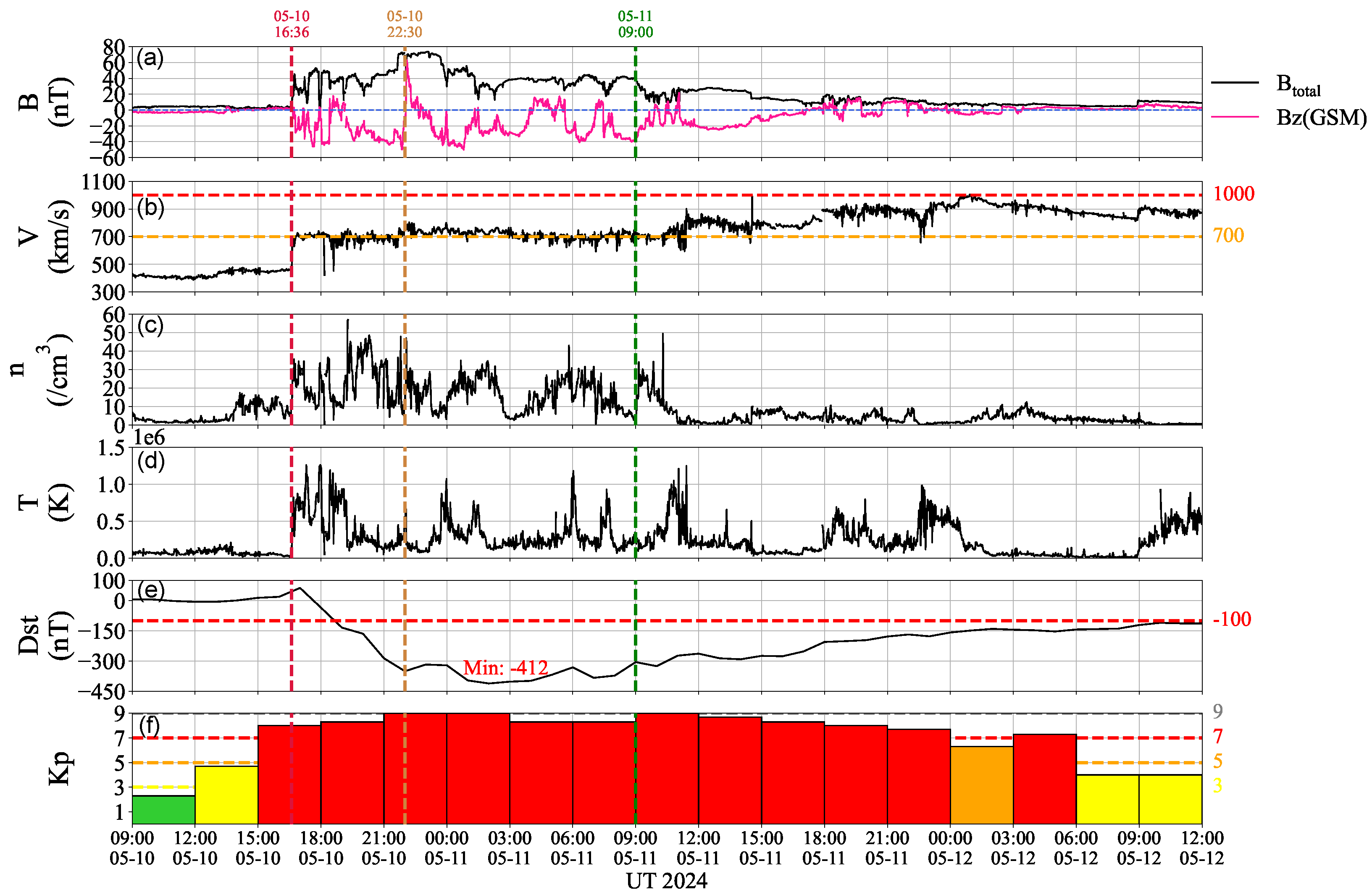
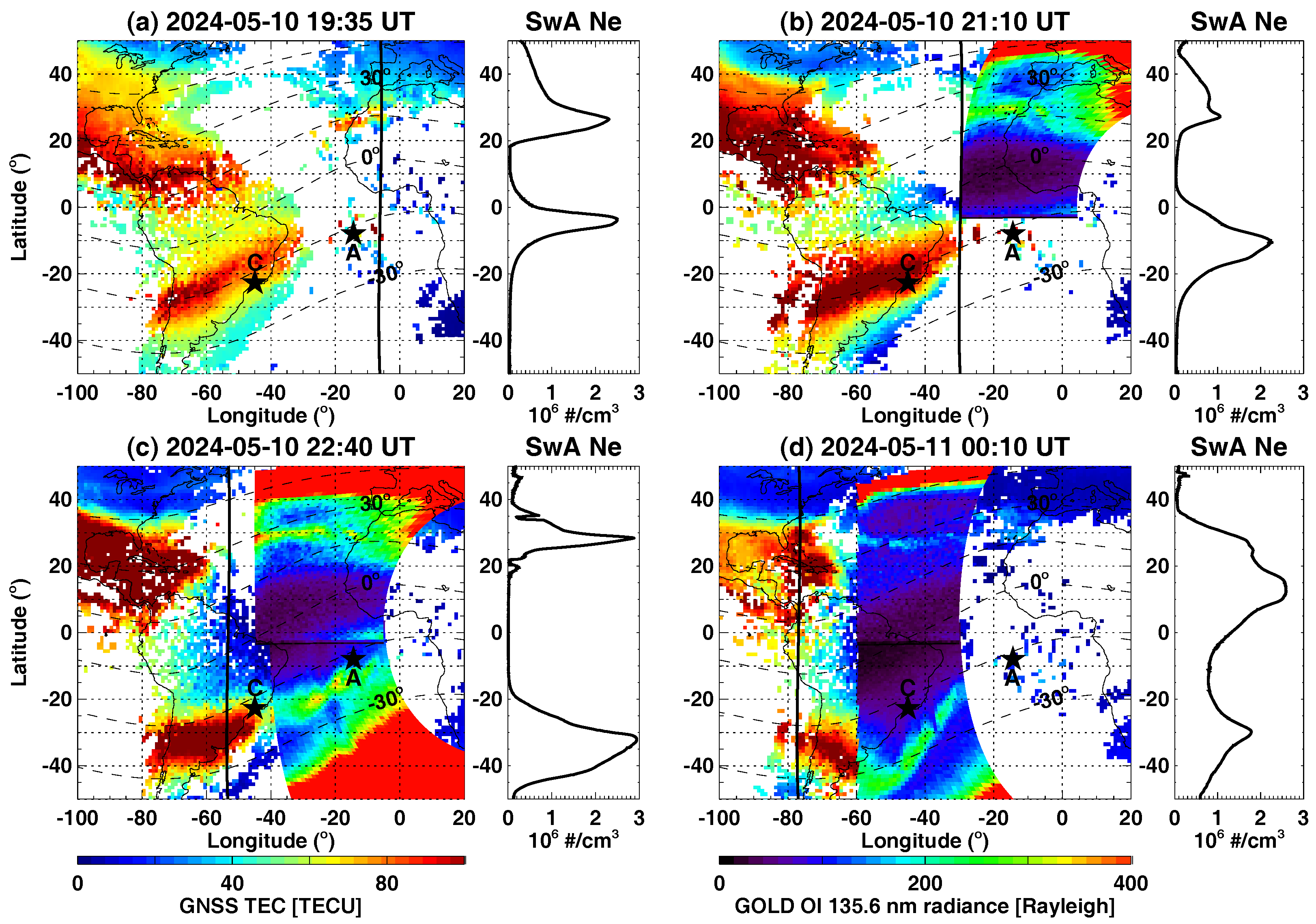

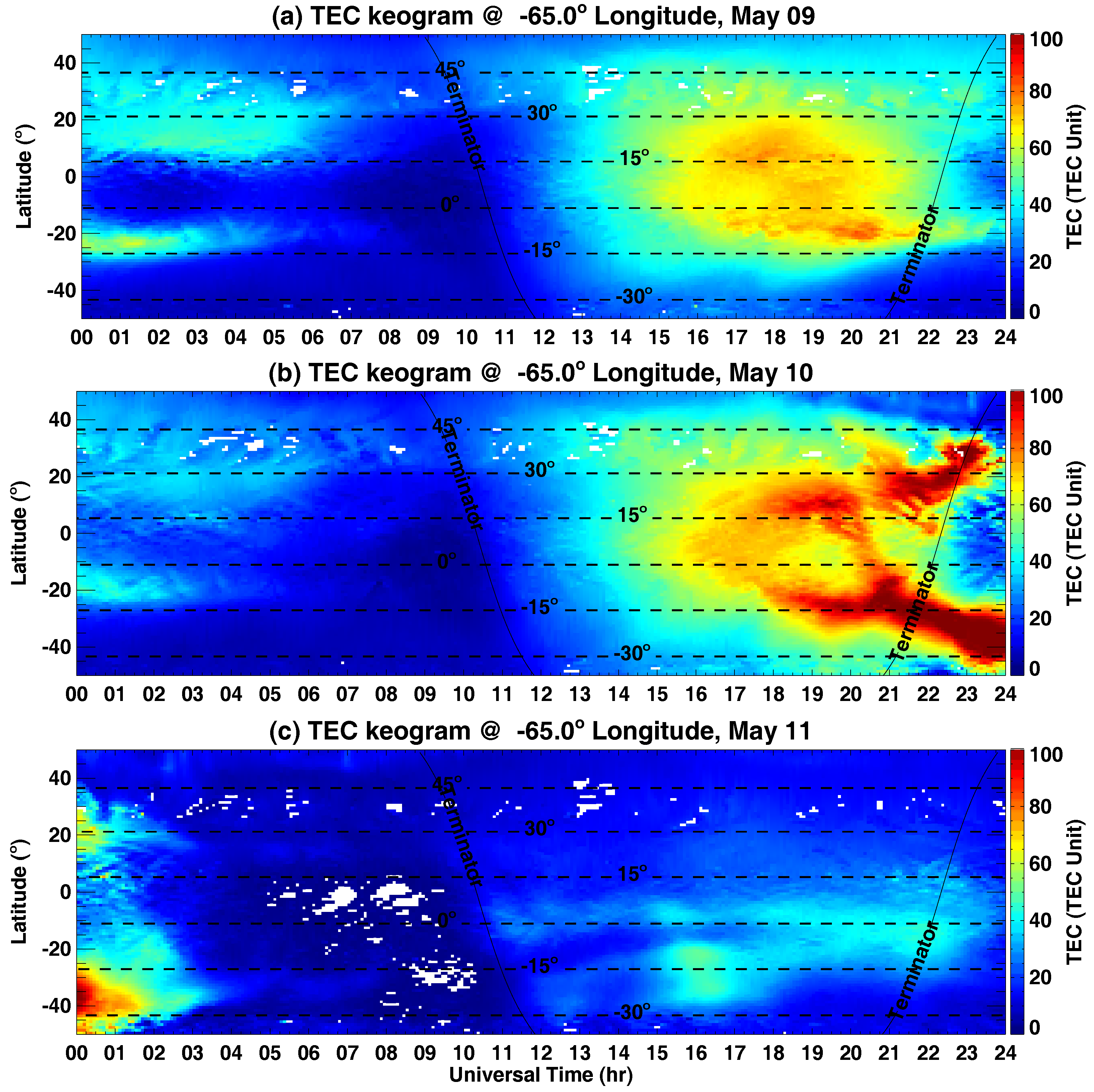
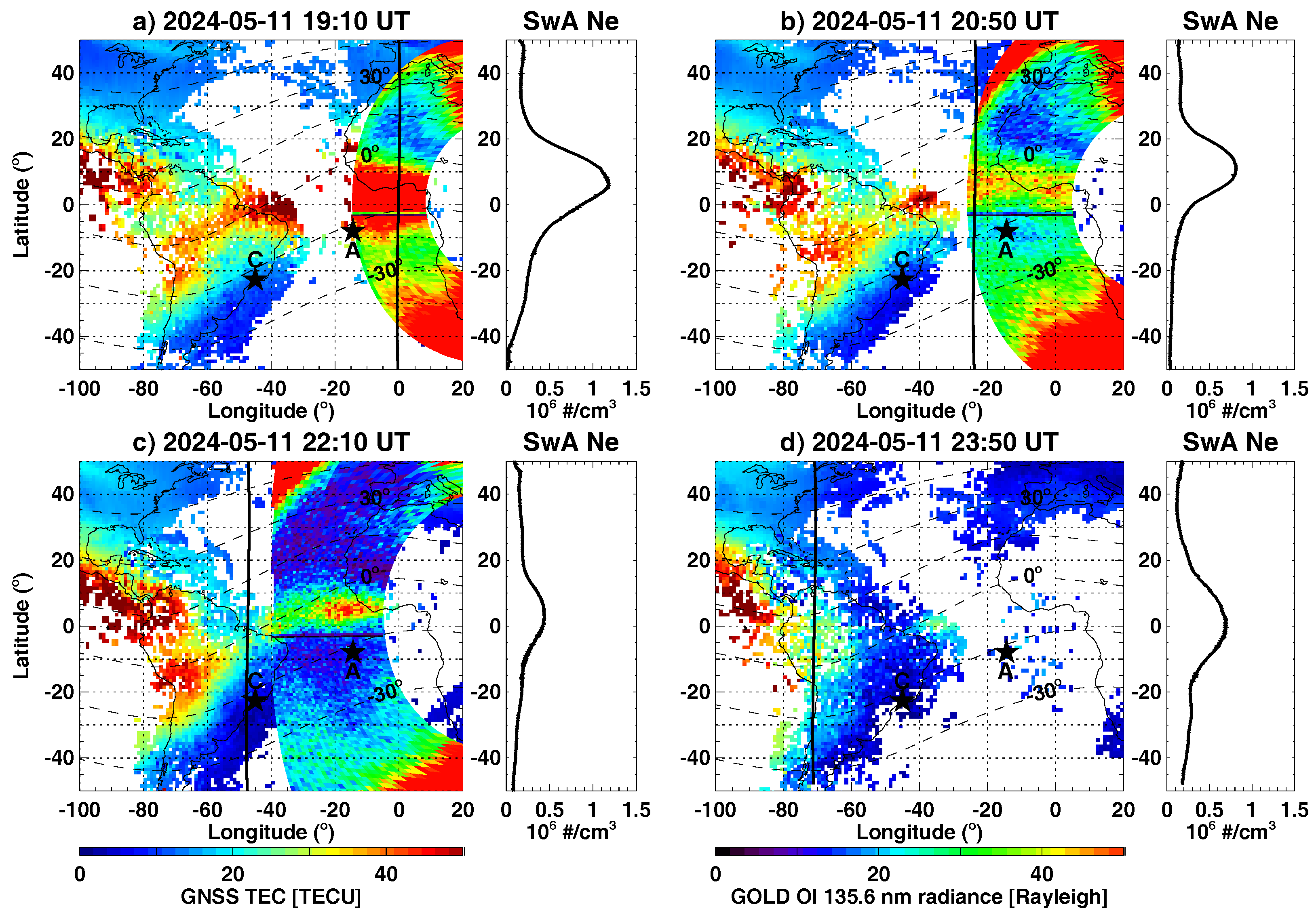
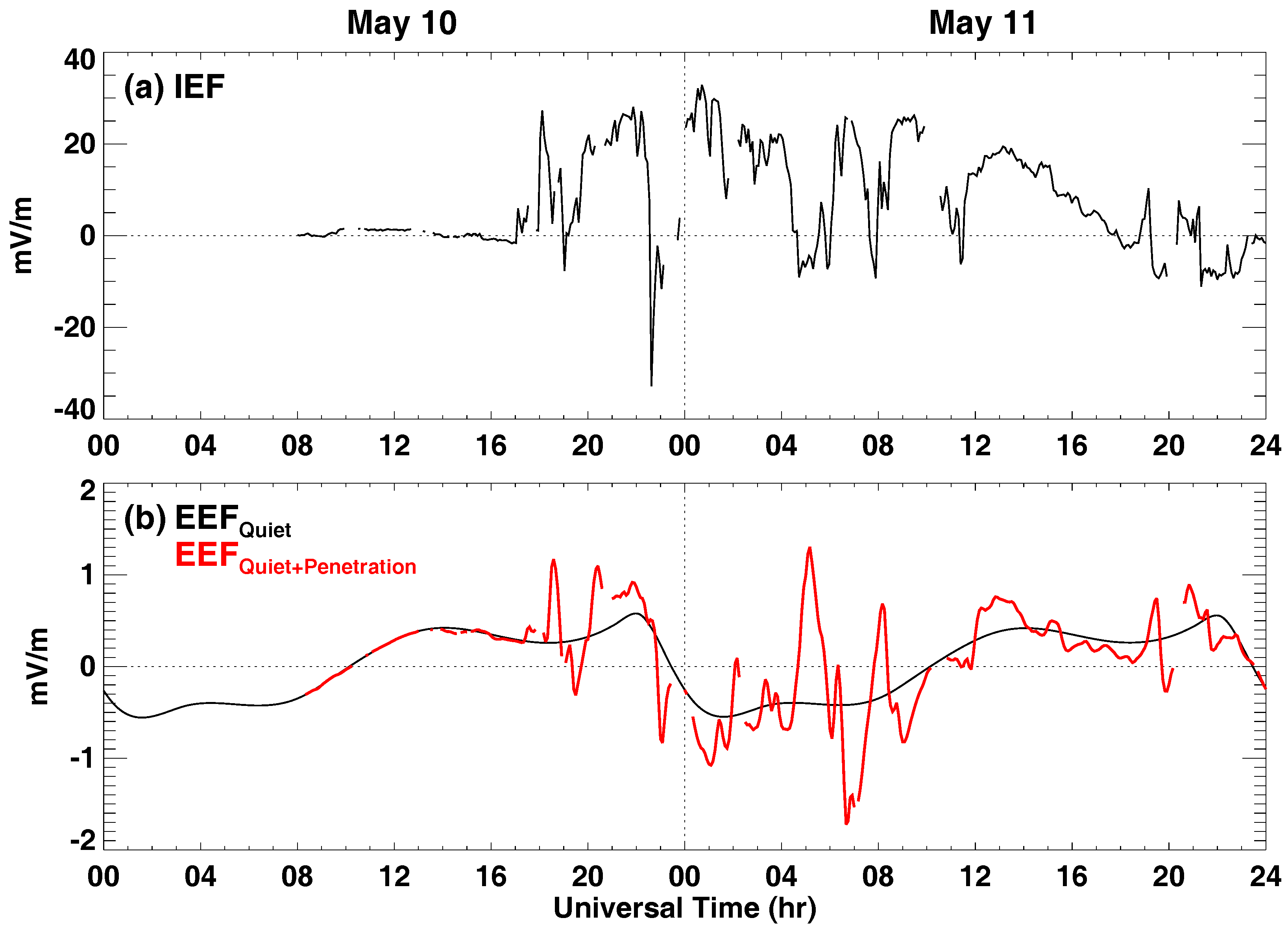
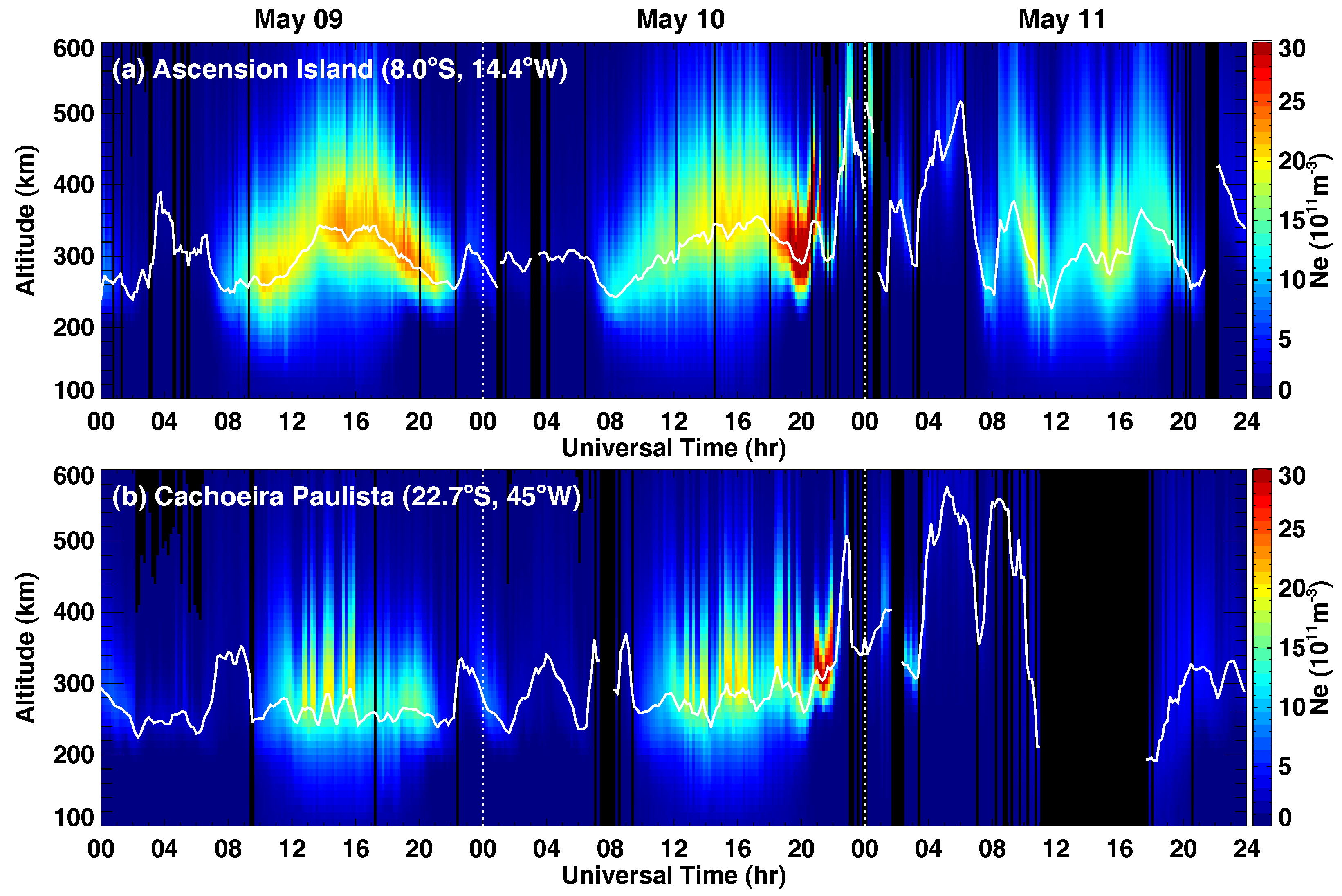
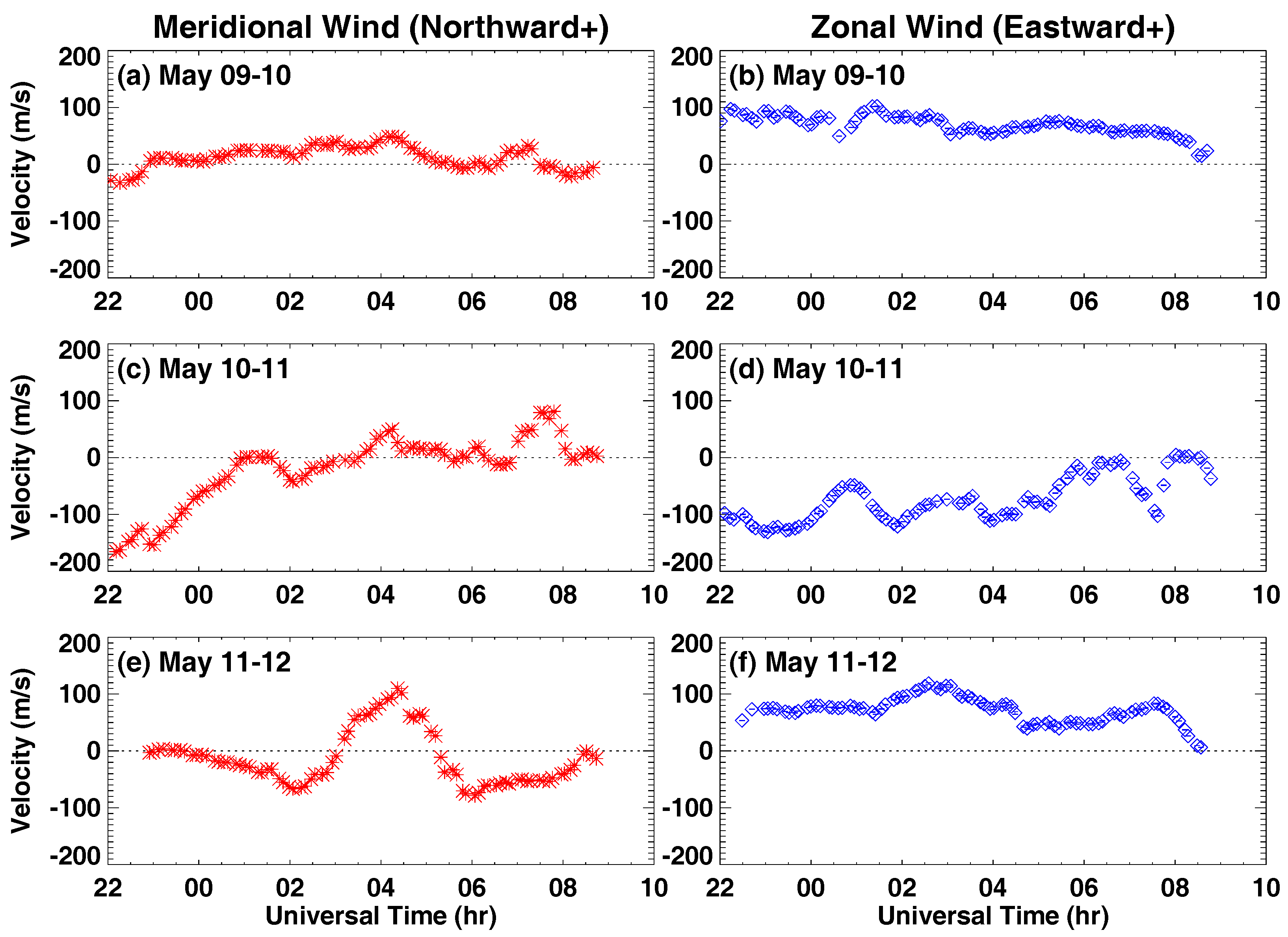
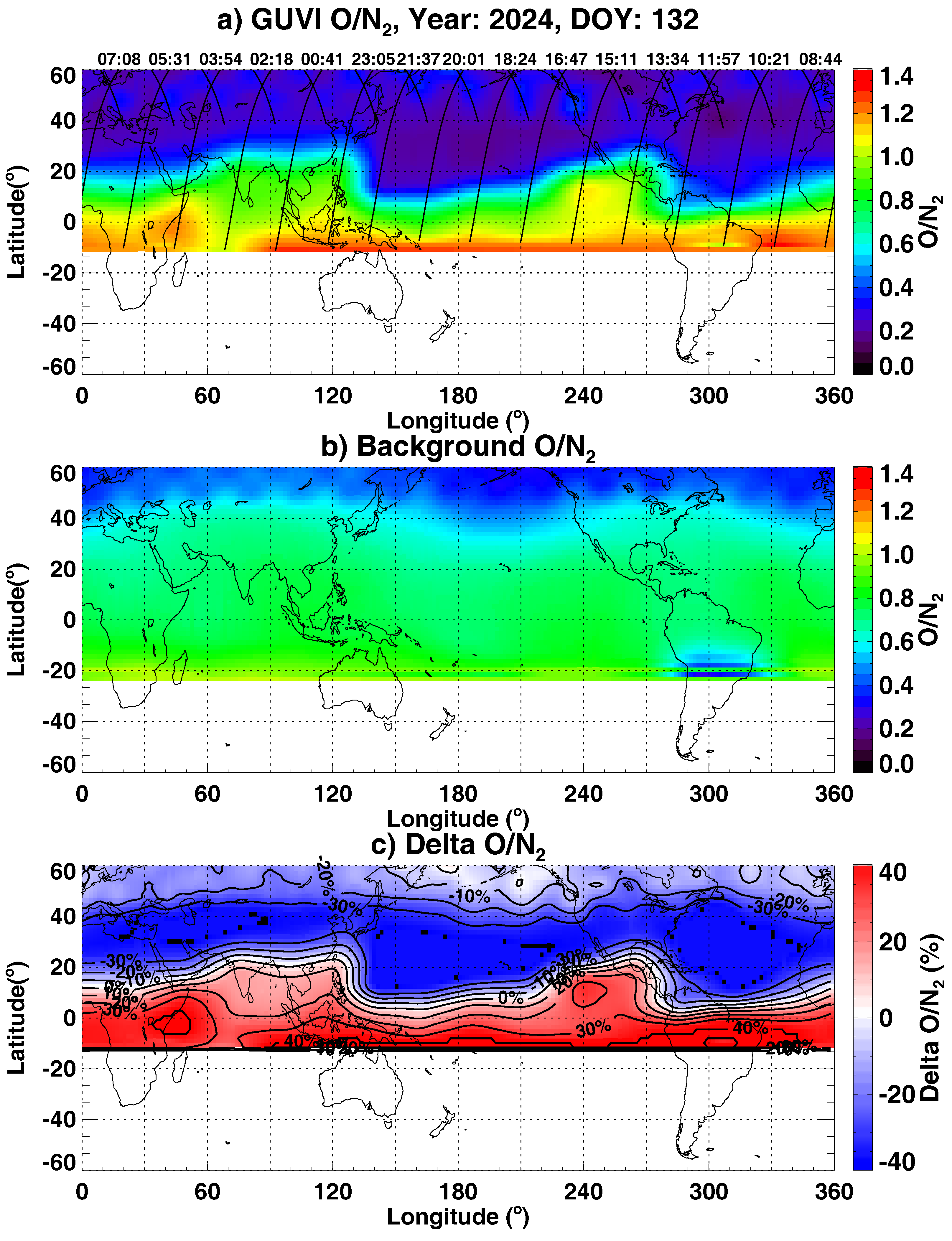
Disclaimer/Publisher’s Note: The statements, opinions and data contained in all publications are solely those of the individual author(s) and contributor(s) and not of MDPI and/or the editor(s). MDPI and/or the editor(s) disclaim responsibility for any injury to people or property resulting from any ideas, methods, instructions or products referred to in the content. |
© 2024 by the authors. Licensee MDPI, Basel, Switzerland. This article is an open access article distributed under the terms and conditions of the Creative Commons Attribution (CC BY) license (https://creativecommons.org/licenses/by/4.0/).
Share and Cite
Aa, E.; Chen, Y.; Luo, B. Dynamic Expansion and Merging of the Equatorial Ionization Anomaly During the 10–11 May 2024 Super Geomagnetic Storm. Remote Sens. 2024, 16, 4290. https://doi.org/10.3390/rs16224290
Aa E, Chen Y, Luo B. Dynamic Expansion and Merging of the Equatorial Ionization Anomaly During the 10–11 May 2024 Super Geomagnetic Storm. Remote Sensing. 2024; 16(22):4290. https://doi.org/10.3390/rs16224290
Chicago/Turabian StyleAa, Ercha, Yanhong Chen, and Bingxian Luo. 2024. "Dynamic Expansion and Merging of the Equatorial Ionization Anomaly During the 10–11 May 2024 Super Geomagnetic Storm" Remote Sensing 16, no. 22: 4290. https://doi.org/10.3390/rs16224290
APA StyleAa, E., Chen, Y., & Luo, B. (2024). Dynamic Expansion and Merging of the Equatorial Ionization Anomaly During the 10–11 May 2024 Super Geomagnetic Storm. Remote Sensing, 16(22), 4290. https://doi.org/10.3390/rs16224290






